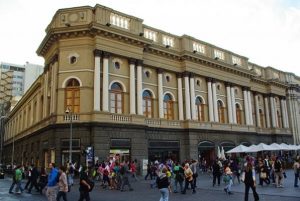Overview
The building where the Archbishopric of Santiago is currently housed. The land on which it is set corresponds to the sites that the Spanish conquistador, Pedro de Valdivia, assigned to the Church during the founding of the city.
In 1850, when Santiago was promoted to Archbishopric, construction began on the Archbishop’s Palace as a way of improving the precarious state of the previous building.
It was declared a National Monument in 1975.
History
When the city was laid out, the conquistador, Pedro de Valdivia, assigned lots of land located on the west side of the Plaza de Armas to the Church. In one of them the first rectory was built.
However, that building lasted until the hosts of Michimalonco destroyed it in their assault on Santiago. The second house was built in 1542. Nineteen years later, when the Bishopric of Santiago was established, a two-story house was built facing the square.
Around 1850, when the city had been raised to the status of Archbishopric, the Cathedral and the Chapel of the Tabernacle (Capilla del Sagrario) already had their façades established. Only the Archbishop’s Palace and its facilities were dilapidated, thus deteriorating the overall appearance of the square; this situation led to the construction of a new building.
Work commenced in 1852, but events occurred that delayed its completion, such as the death of the architect in charge, Brunet de Baines, besides difficulties in financing. Work was halted until 1869, when French architect Luciano Henault took charge of its completion.
Architecture
The palace features marked neo-classical features: it is a three-storied terraced building with a rectangular courtyard.
The ground floor on two façades is reserved for commercial premises, while the first floor is highlighted by Doric and Corinthian capital pilasters, in addition to columns running along the façade.
Compañía de Jesús, Santiago.


